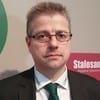Explore all the information on
Swine nutrition
Pigs require a number of essential nutrients to meet their needs for maintenance, growth, reproduction, lactation, and other functions. However, factors such as genetic variation, environment, availability of nutrients in feedstuffs, disease levels, and other stressors may increase the needed level of some nutrients for optimal performance and reproduction.
Swine require six general classes of nutrients: water, carbohydrates, fats, protein (amino acids), minerals, and vitamins. Energy, although not a specific nutrient, is an important nutritional component and is primarily derived from the oxidation of carbohydrates and fats. In addition, amino acids (from protein) that exceed the animal’s requirements for maintenance and tissue protein synthesis provide energy when their carbon skeletons are oxidized. Antibiotics, chemotherapeutic agents, microbial supplements (prebiotics and probiotics), enzymes, and other feed additives are often added to swine diets to increase the rate and efficiency of gain, to improve digestibility, and for other purposes, but they are not considered nutrients.
Pigs require a more concentrated diet and should be fed a less-fibrous feed than cattle, sheep, or horses. As they grow, their nutritional requirements change and the diet should meet their needs in various phases of growth and stages of production.
Introduction Plant carbohydrates can be classified into three categories: 1) simple sugars and their conjugates (glucose, fructose, etc.); 2) storage reserve compounds (starch); and 3) structural carbohydrates (cellulose, hemicellulose, etc.). Simple sugars and storage compounds are primarily digested in the upper gastrointestinal tract of pigs, although not completely, while structural carbohydrates are only partially degraded by the microflora in the cecum and large intestine...
Comments : 2
Recommendations: 1
Introduction One of the characteristics that influence the quality of meat as perceived by the consumer is the amount of intramuscular fat (IMF), which is located within the structure of muscle. In terms of taste, IMF is well correlated with pork acceptability. The threshold level of IMF needed for optimal eating quality of pork proposed is between 2.2 and 3.4% (Font-i-Furnols et al., 2012). In the last decades, the...
Comments : 0
Recommendations: 0
Introduction Protein deposition corresponds to the positive balance between protein synthesis and breakdown (Metayer et al., 2008). In an effort to maximize the protein deposition and optimize nutrient utilization in pig nutrition, it is necessary to determine the amino acid requirement for protein deposition in each growth stage. Lysine has been an amino acid of great interest due to its constancy in body protein and its metabolic preferential allocation for the deposition of...
Comments : 0
Recommendations: 0
Introduction Corn distillers dried grains with solubles (DDGS) is a rich source of protein and amino acids (AA) for pig feed (Stein and Shurson, 2009b). However, the high variation in DDGS AA composition and relatively low AA digestibility may play a role in its limited use in swine diets (Fastinger and Mahan, 2006; Liu, 2011). The ratio of wet distillers grains (WDG) and condensed distillers solubles (CDS) was considered to be one of most important...
Comments : 0
Recommendations: 0
Introduction L-carnitine (LC) is a naturally occurring and widely distributed in nature compound. It was discovered in 1905 in Liebig’s meat extracts, a popular ‘dietary supplement’ at that time, by Gulewitsch and Krimberg [1] who named the substance from the Latin word for flesh (“carnus”). Carnitine chemical structure was established in 1927 and its function was related to long-chain fatty...
Comments : 0
Recommendations: 0
Disease Prevention
Through Biosecurity”
By: Paul Walker Thompson March 13, 2016
Biosecurity is a big buzz word these days in the Hog Industry, and is of huge importance to the well-being of each farm. There are two aspects to Biosecurity that help us prevent or reduce the effects of disease, (A) External Biosecurity, and (B) Internal Biosecurity. Let’s take a quick look at each of these.
(A) External Biosecurity is Disease Prevention Measures such as a fence around the farm...
Comments : 26
Recommendations: 0
Bernardo Valenti, a researcher at the University of Catania, in Italy, gave the presentation of his research "Tannins: Review of Mechanism of Action in Animal Nutrition" to the attendees at Silvafeed Technical Seminar in Bangkok, just before VIV Asia 2017, In Thailand....
Comments : 2
Recommendations: 0
Introduction Feed represents between 60 and 70 % of the total cost of pork production in modern capital-intensive systems. Within feed, energy alone may represent 50 % or more of the total cost [1]. Carbon-containing compounds in the feed, including fat, carbohydrate and protein, release energy when oxidized. Such energy is required for such processes as the biosynthesis of proteins, bones and lipids, for biochemical processes associated with maintenance, for active ion...
Comments : 0
Recommendations: 2
Introduction Livestock production in confinement facilities results in gas emissions such as ammonia (NH 3 ), methane (CH 4 ), nitrous oxide (N 2 O) and carbon dioxide (CO 2 ). In pig production, NH 3 , CH 4 and N 2 O are products of manure decomposition while CO 2 is primarily a product of animal metabolism. Ammonium (NH 4 + ), under acidic or neutral pH conditions or NH 3 at...
Comments : 0
Recommendations: 1
Introduction Spray dried porcine plasma (SDPP) is a dehydrated product obtained from blood of healthy pigs collected at slaughterhouses. Spray dried porcine plasma is a protein source used in pig feed that has many functional components that significantly improves pig performance [1,2]. At a manufacturing plant, plasma is separated from red blood cells by centrifugation,...
Comments : 0
Recommendations: 2
The weaning process is a stressful one for piglets. A new environment, penmates and feed source can all impact their feed intake and growth potential. Meeting their essential nutritional needs during this transition is critical to minimizing stress and maximizing feed efficiency, overall health and performance. Certain nutritional elements, although needed only in small amounts, are important for maintaining young animal health. Copper is one of those elements and is...
Comments : 3
Recommendations: 0
ReportsWeb.com added “Global Methionine Market Research Report 2017” to its vast collection of research Database. The report is spread across 107 pages and supported by 8 company leaders.
The Global Methionine Market Research Report 2017 is a professional and in-depth study on the current state of the Methionine Market. This report studies Methionine in Global market, especially in North America, Europe, China, Japan, Korea and Taiwan, focuses on top manufacturers in...
Comments : 0
Recommendations: 0
INTRODUCTION The swine industry has largely gone to early weaning (3 weeks or earlier) especially in confinement production systems with environmentally controlled nurseries. Economic factors such as increasing the number of pig per sow per year and the need to maximize the capital cost of swine farrowing units by moving more sow through the facilities has resulted in this change. Two essential factors for early weaning are: ...
Comments : 1
Recommendations: 0
Jacob Dall, Technical and R&D Manager at Vilofoss, talks to us about the company's developments in finding solutions for the pig industry during Eurotier 2016, in Hannover, Germany....
Comments : 0
Recommendations: 1
Introduction: The limited ability to induce classical vitamin D deficiencies, and challenges to identify traits which adequately assess vitamin D requirements, such as measurements of body tissue and serum concentrations, complicate recommendations for dietary fortification and lead to speculative hype (Crenshaw et al, 2014). These constraints and limited research efforts are especially noted for recommendations in sow gestation and lactation...
Comments : 0
Recommendations: 2
Background Spray-dried porcine plasma (SDPP) as an ingredient in diets for nursery pigs is well recognized to improve growth rate, feed intake, feed efficiency, and to reduce post-weaning diarrhea, mortality, and morbidity [1,2]. In addition, weaned pigs fed diets supplemented with SDPP had reduced intestinal inflammation, mucosal barrier dysfunction, and diarrhea [3]. ...
Comments : 0
Recommendations: 0
Dr Tobias Steiner, Head of Product Management Sangrovit® for Phytobiotics, talks to us about the company and their key product, Sangrovit®, during Eurotier 2016, in Hannover, Germany. ...
Comments : 0
Recommendations: 1
Dr. Ruurd Zijlstra (University of Alberta) explains how to control gut health in pigs, fermentation and energy efficiency, during CLANA 2016 in Cancun, Mexico....
Comments : 0
Recommendations: 0
...
Comments : 0
Recommendations: 0
1. INTRODUCTION Much has been said and written about feed intake in the pig. It is therefore surprising that it remains a topic of much interest to pork producers, as we appear to be continually challenged to reach a maximum, or at least an optimum, level of feed intake on a consistent basis. However, the focus on feed intake is not surprising in that it is the ultimate driver of growth. It would be difficult to...
Comments : 1
Recommendations: 0












.jpg&w=3840&q=75)













.mp4&w=3840&q=75)







